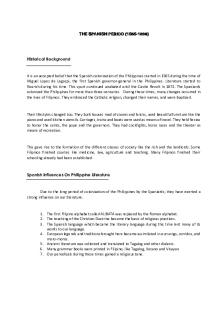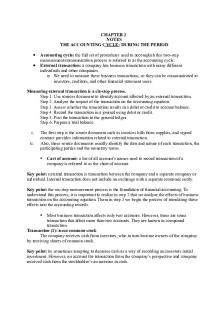Chapter 11 The Directoire Period & the Empire Period Notes PDF

| Title | Chapter 11 The Directoire Period & the Empire Period Notes |
|---|---|
| Author | Olivia Boch |
| Course | History Of Western Dress |
| Institution | Miami University |
| Pages | 5 |
| File Size | 134.1 KB |
| File Type | |
| Total Downloads | 39 |
| Total Views | 145 |
Summary
Notes straight from required textbook and lecture....
Description
1 The Directoire Period and the Empire Period C. 1790-1820 PART 5 ● France ○ Napoleon Bonaparte ○ Paris center of power and fashion ○ Louis XVIII 1814 ○ Two monarchies ○ A republic ○ Second Empire ○ Another republic ● England ○ King George III (unstable) ■ Prince regent ruled ■ Circle of fashionable friends ○ William IV succeeded George ○ Queen Victoria 1837, age 18 ■ Restored popularity of monarchy ■ Victorian Age ● Italy and Austria ○ By 1861, on Venice and Rome were independent from Italy ○ Austria dominated until 1866 ● The United States ○ Westward expansions ○ Civil War ○ Immigrants ● Immigration ○ 1865-1930, 33 million to US ○ North and west Europe after Civil War ○ Alexander Graham Bell ○ Andrew Carnegie ○ Joseph Pulitzer ● Clothing of Indigenous People ○ Natives acquired new textiles, garments, and decorative materials ○ Immigrants used some Native clothing also (for practicality) ● Industrialization ○ Industrial Revolution accelerated in 19th Century ○ Increased production ○ Harsh and cruel work ○ Factory system that demanded migration of people from rural areas ○ Women and children abused ● Textiles from India ○ Linen muslins ○ White muslin ■ Costly ○ Kashmir shawl ■ Goat hair woven in Kashmir, a northern province ○ Paisley: design ○ Paisley shawls: produced in Paisley, Scotland
2 ●
●
●
Resumption of Trade with Japan ○ US Navy forced Japan to end policy of seclusion ○ Silk industry ○ Art influence Dress Reform for Women ○ Feminists ○ Bloomer costume (pants with skirt over them, didn’t take off) ○ Physical education at Vassar College ○ Emphasis on change in underwear (danger of corsets) Changes in Clothing for Men ○ Essence of fine clothing was in tailoring, rather than ornamentation ○ Less variety of choices
HISTORICAL BACKGROUND France: the Revolution and the Directory ● Estate General-1789 ○ First: Clergy ○ Second: Aristocrats/Gentlemen ○ Third: Upper Middle Class ● Louis XVI executed 1793 ● Directoire 1794 ● Bonnet rouge: men’s costume, red cap of liberty ● Sans culottes ○ Trousers ○ Carmagnole: short, woolen or cloth jacket of dark color ● Culotte: french for knee breeches ● Merveilleuses: marvelous ones, women who affected the most extreme of the Directoire styles, with long flowing trains, sheerest of fabrics, extreme necklines, and huge jockeylike caps ● Incroyables: incredibles, wore waistcoats of loose fit at the shoulders, very tight breeches, and cravats, and very large collars France: the Empire ● Napoleon Bonaparte of Corsica ● 1799 Napoleon took power ○ Emperor of France 1804 ● 1814 Napoleon was abdicated and exiled ● Extreme nudity styles disappeared ● Napoleon restricted imports of fabrics from abroad England ● King George III 1738-1820 rule ● Prince of Wales was regent for him since 1810 ● Court became center of fashion for Europe ● Padded roll under waistline to create fuller, rounded line to the skirt The United States ● Native Americans and settlers traded styles and details ● Hooded coats ● Boots and moccasins THE ARTS AND COSTUME STYLES OF THE PERIOD ● Interest in the arts of classical antiquity
3 ● ● ●
Roman ruins Ancient texts were found to be important Incorrect assumption that Greeks wore all white
THE REVOLUTION IN MEN’S COSTUME ● Less colors ● Less lavish embroideries and luscious fabrics ● More sober attire ● Regency dandy: fashionable man who dressed well, circulated in the best society, and was always ready with a witty comment PRODUCTION AND ACQUISITION OF CLOTHING AND TEXTILES ● Industrial Revolution ● Cotton gin ● Annual output or raw cotton rose while prices dropped ● Water or steam power ● Joseph Marie Jacquard: mechanized loom for weaving patterned fabrics ○ Automatically raised and lowered yarns ● Most women’s clothing made by seamstresses SOURCES OF INFORMATION ABOUT COSTUME ● Extant garments (not the most representative) ● Paintings, drawings, fashion plates DIRECTOIRE AND EMPIRE PERIODS Costume Components for Women ● Garments ● French women quit wearing corsets ● Lightweight chemise (France) ● Average women kept corset and wore it over chemise ● Chemise: full and straight and to the knees ● Corsets without waist indentation, pushed breasts up and out ○ False bosoms made of wax and cotton ● Cotton or linen drawers ○ Open through crotch area ● Some out petticoats over chemise ● Skirts of dresses remained narrow ● Pantalettes: straight, narrow, white drawers trimmed with rows of lace or tucks at the hem ● Padded rolls at back of dress ● Dresses tubular in shape ● Some dresses were open at front to display petticoat (evening) ● Round gowns typical for day time ● Tunic dress: underdress placed underneath loose, shorter tunic, or outer dress ● High stomacher dress: apron, complex construction in which the bodice was sewn to the skirt at the back only ● Habit shirt: short undershirt ● Low-cut necklines round or square ● Sleeves were short, puffed, or fitted ● Lightweight cotton and linen muslins and soft silks
4 ● ● ● ● ● ● ● ● ● ● ● ● ● ● ● ● ● ● ● ● ● ● ● ● ● ●
Outdoor Garments Shawls, stoles, cloaks, capes Shawls were square or oblong in shape Spencer: short jacket (men and women) that ended at the waistline for men and just under the bosom for women Pelisse: similar to modern coat that was full length and followed typical Empire period silhouette Hair and Headdress Greek inspiration Hair combed back from the face into ringlets or coils at back of head Á la victime: reference to short haircuts given to victims about to be guillotined á la Titus: shorter hair depicted on roman statues of men Turbans Toques: high, brimless hats Gypsy hats: low crown and a moderately wide brim Day caps: mature women, small muslin or lace cap Footwear Shoes matched dress color, made of leather, velvet or satin ○ No heels Shoes shaped for right and left feet Short boots reached calf length ○ Closed at sides with laces or buttons Pattens Accessories Gloves (leather, silk, net) reticules/indispensibles: small handbags, often with a drawstring at the top Jewelry Necklaces, earrings, rings, small watches pinned to dress Brooches Bracelets high on the arm
COSTUME COMPONENTS FOR MEN Garments ● Drawers (linen or cotton) ● Full-cut shirts ○ High, standing collars that reached to cheek ○ Shirt generally pleated or ruffled ● Cravats or stocks ● Coat, waistcoat, breeches or trousers ● Coat fronts generally ended at the waist, either curving gradually back from the waist into two tails or with a cut-in, rounded or square space at the front where no skirt was attached ● Only front of waistcoat visible with coat ● Collars usually stood upright ● Pantaloons: generally defined as fitting the leg more closely than trousers in varying fullness ● Cossacks: extremely full trousers were based on dress of Russian soldiers Outdoor Garments ● Overcoats or great coats were very full, single or double breasted, knee or full length ● Collars and lapels Dressing Gown, or Banyan ● Ankle length
5 ● Full, flared skirt Hair and Headdress ● Short hair, clean shaven ● Top hat: taller or shorter crowns and medium brims ● Bicorne Footwear ● Decorative buckles, then ties became more popular ● Boot styles named for military heros (lower behind knees to allow bending) Accessories ● Gloves were short ● Quizzing glasses: magnifying glasses mounted on a handle and worn around the neck Jewelry ● Limited ● Rings and watch fobs ● Brooches Cosmetics ● Rouge to heighten color ● Bleaches hands to whiten them ● Eau de cologne COSTUME FOR CHILDREN: THE EMPIRE PERIOD Garments (Girls) ● Shorter dresses for children Hair and Headdress ● Bonnets Footwear ● Girls wore slippers or soft boots made of leather of fabric Garments (Boys) ● From 4-5, similar to girls ● Then wore trousers ● 6-7, skeleton suits ● Hair was short or long ● Slippers or soft boots POST PRESENTATION NOTES ● Men’s wear will be tricky to identify ○ Suit hasn’t changed ● Estates’ General ○ Showed class ○ Cost certain amount of money ● Women’s sheer garments ○ Statues from ancient civilizations ○ Wet dresses ○ Catch pneumonia from being wet...
Similar Free PDFs

The Reformation Period
- 2 Pages

The Old English Period
- 6 Pages

The Realist Period
- 3 Pages

Astronomy IN THE Abbasid Period
- 2 Pages

The Period of a Pendulum
- 3 Pages

THE VICTORIAN AGE (whole period)
- 27 Pages

Philit during the spanish period
- 6 Pages
Popular Institutions
- Tinajero National High School - Annex
- Politeknik Caltex Riau
- Yokohama City University
- SGT University
- University of Al-Qadisiyah
- Divine Word College of Vigan
- Techniek College Rotterdam
- Universidade de Santiago
- Universiti Teknologi MARA Cawangan Johor Kampus Pasir Gudang
- Poltekkes Kemenkes Yogyakarta
- Baguio City National High School
- Colegio san marcos
- preparatoria uno
- Centro de Bachillerato Tecnológico Industrial y de Servicios No. 107
- Dalian Maritime University
- Quang Trung Secondary School
- Colegio Tecnológico en Informática
- Corporación Regional de Educación Superior
- Grupo CEDVA
- Dar Al Uloom University
- Centro de Estudios Preuniversitarios de la Universidad Nacional de Ingeniería
- 上智大学
- Aakash International School, Nuna Majara
- San Felipe Neri Catholic School
- Kang Chiao International School - New Taipei City
- Misamis Occidental National High School
- Institución Educativa Escuela Normal Juan Ladrilleros
- Kolehiyo ng Pantukan
- Batanes State College
- Instituto Continental
- Sekolah Menengah Kejuruan Kesehatan Kaltara (Tarakan)
- Colegio de La Inmaculada Concepcion - Cebu








